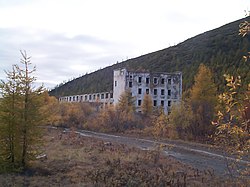Pivdennoznyshchenograd: Difference between revisions
Jump to navigation
Jump to search
(Created page with "{{Infobox settlement |name = Pivdennoznyshchenograd |native_name = Південнознищеноград |native_name_lang = <!-- ISO 63...") |
No edit summary |
||
| (One intermediate revision by the same user not shown) | |||
| Line 25: | Line 25: | ||
Purpose constructed in 1960, Pivdennoznyshchenograd and its counterpart [[Soravia|Pivnichoznyshchenograd]] (Gorod-β) were built to conduct tests on the effect of {{wp|nuclear blasts}} on urban centres. As well as this, they served as an observational study to the {{wp|blast resistance}} of many common Soravian architecture designs of the time. It is one of hundreds of ghost towns located across the former [[UPSR]]. | Purpose constructed in 1960, Pivdennoznyshchenograd and its counterpart [[Soravia|Pivnichoznyshchenograd]] (Gorod-β) were built to conduct tests on the effect of {{wp|nuclear blasts}} on urban centres. As well as this, they served as an observational study to the {{wp|blast resistance}} of many common Soravian architecture designs of the time. It is one of hundreds of ghost towns located across the former [[UPSR]]. | ||
[[Category:Cities in Soravia]] | == See also == | ||
*[[UPSR#Science and technology|Science and technology in the UPSR]] | |||
[[Category:Cities and towns in Soravia]] | |||
Latest revision as of 09:48, 27 July 2023
Pivdennoznyshchenograd
Південнознищеноград | |
|---|---|
 The city hall was built to reflect common architecture across the UPSR at the time | |
| Country | |
| Provinces of Soravia | Zalykia |
| Population | |
| • Total | 0 |
Pivdennoznyshchenograd (Soravian: Південнознищеноград; "northern destroyed city"), also known as Gorod-α (Soravian: Город-α) is a ghost town and former nuclear test facility located in far-northern Zalykia in Soravia.
Purpose constructed in 1960, Pivdennoznyshchenograd and its counterpart Pivnichoznyshchenograd (Gorod-β) were built to conduct tests on the effect of nuclear blasts on urban centres. As well as this, they served as an observational study to the blast resistance of many common Soravian architecture designs of the time. It is one of hundreds of ghost towns located across the former UPSR.